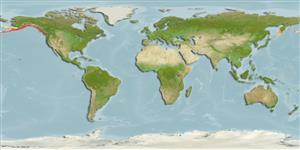Environment: milieu / climate zone / depth range / distribution range
Ecology
Marine; demersal; depth range 0 - 225 m (Ref. 50610). Temperate; 66°N - 46°N
Northeast Pacific: Bering Sea to southern Puget Sound, Washington, USA.
Size / Weight / Age
Maturity: Lm ? range ? - ? cm
Max length : 8.3 cm TL male/unsexed; (Ref. 2850)
Short description
Identification keys | Morphology | Morphometrics
Dorsal spines (total): 22; Dorsal soft rays (total): 15; Anal spines: 0; Anal soft rays: 14 - 15. Dorsal spines and rays covered with skin; caudal rounded; pelvic fins partly attached to body (Ref. 6885). Color variable, changing rapidly; translucent pink to gray or brown on dorsal surface, lighter on fins; pectoral fins pale or bright orange; some dark spots on fins and vague darker markings on body; sometimes spotted; eyes orange (Ref. 6885).
Occurs in rocky areas, among sponges; also found on soft bottoms (Ref. 2850).
Life cycle and mating behavior
Maturities | Reproduction | Spawnings | Egg(s) | Fecundities | Larvae
Eschmeyer, W.N., E.S. Herald and H. Hammann, 1983. A field guide to Pacific coast fishes of North America. Boston (MA, USA): Houghton Mifflin Company. xii+336 p. (Ref. 2850)
IUCN Red List Status (Ref. 130435)
Threat to humans
Harmless
Human uses
Tools
Special reports
Download XML
Internet sources
Estimates based on models
Preferred temperature (Ref.
123201): 1.6 - 8.6, mean 5.6 °C (based on 233 cells).
Phylogenetic diversity index (Ref.
82804): PD
50 = 0.5005 [Uniqueness, from 0.5 = low to 2.0 = high].
Bayesian length-weight: a=0.00389 (0.00180 - 0.00842), b=3.12 (2.94 - 3.30), in cm total length, based on all LWR estimates for this body shape (Ref.
93245).
Trophic level (Ref.
69278): 3.2 ±0.5 se; based on size and trophs of closest relatives
Fishing Vulnerability (Ref.
59153): Low vulnerability (10 of 100).
